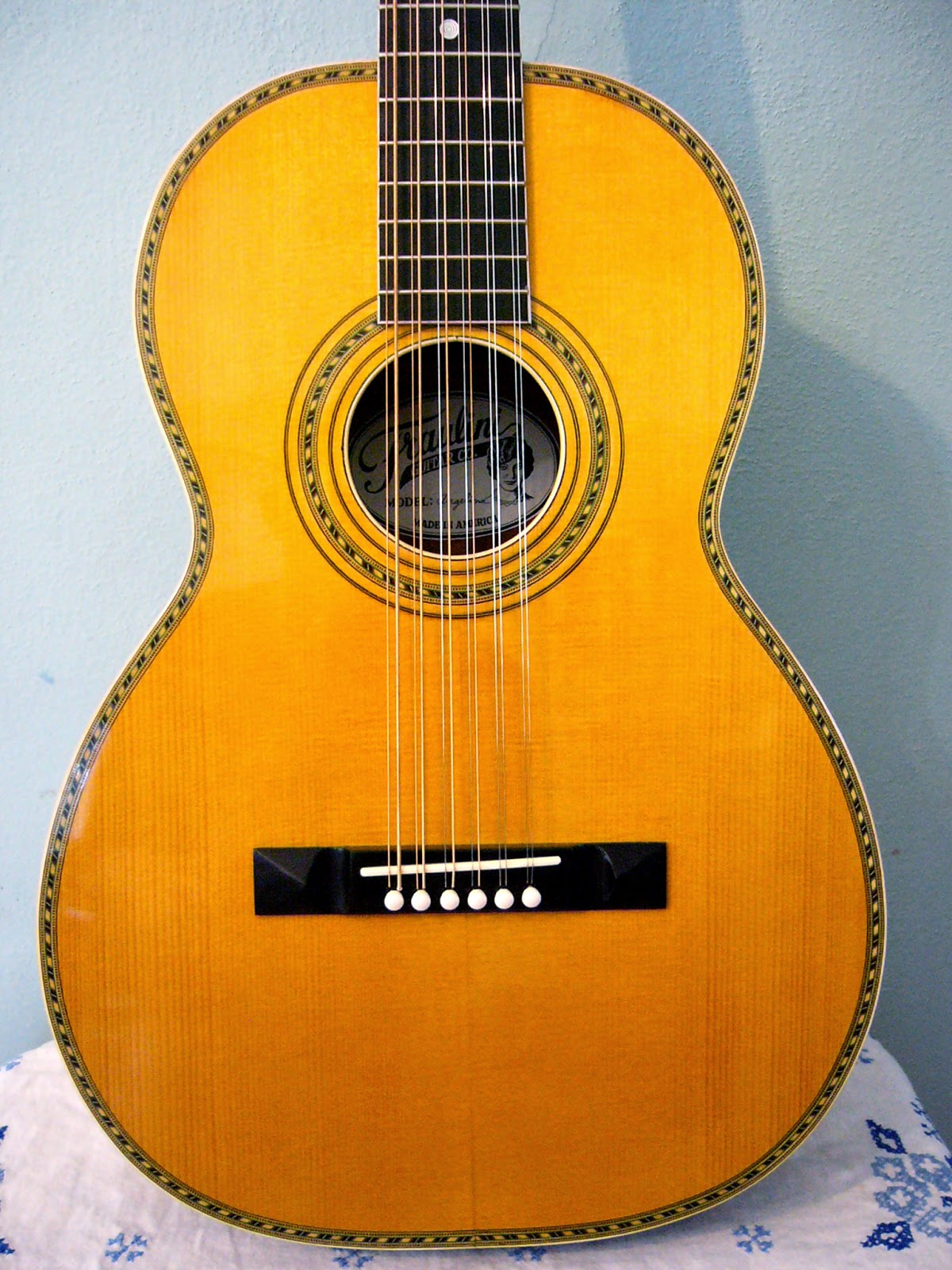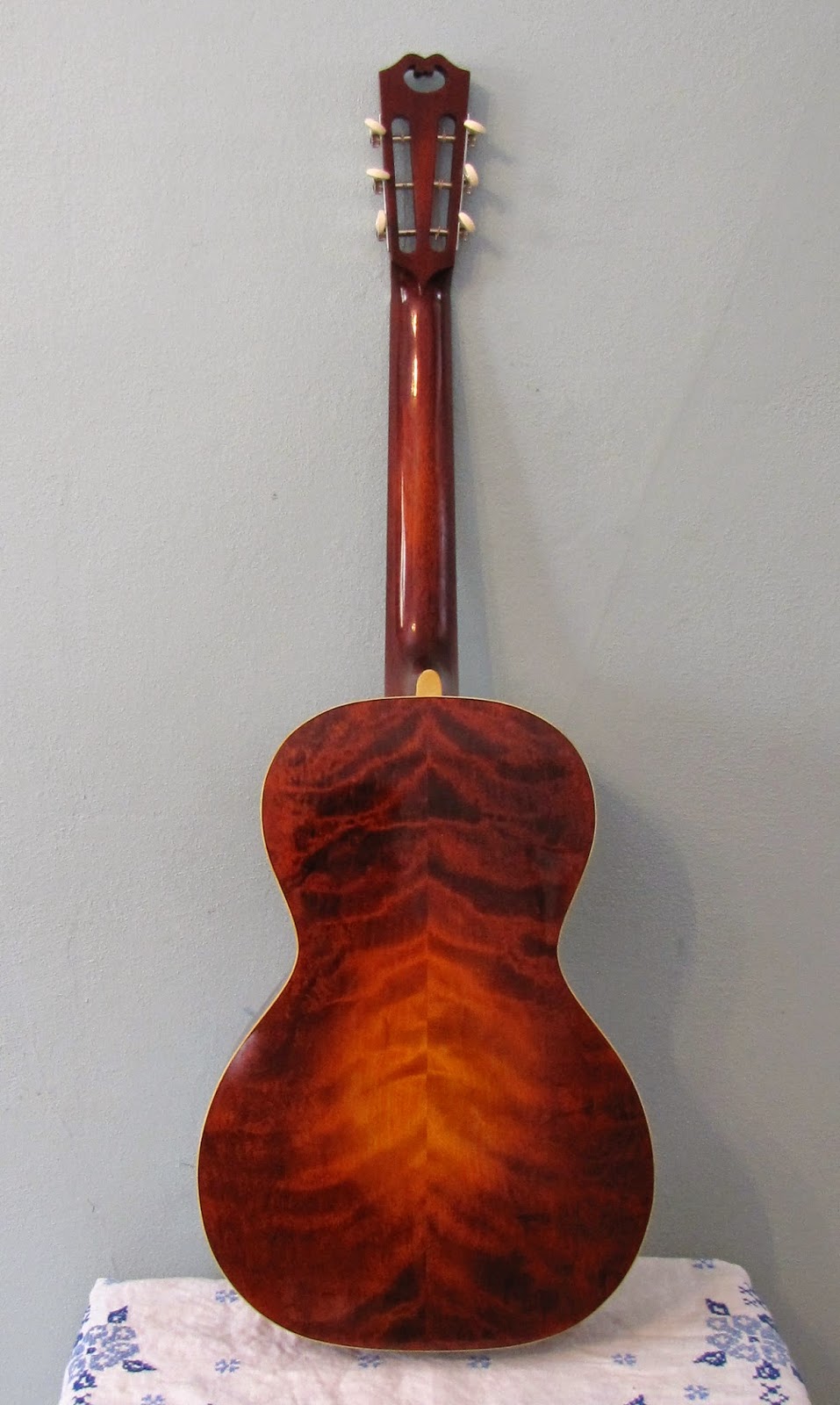 |
| Willie McTell with his Tonk 12, late 1920s. |
One of the sources I draw on for inspiration for new projects is old photographs of musicians with their guitars. I have been especially interested in trying to recreate the instruments of some of America's most iconic musicians. I have made copies of Leadbelly's 12 string, Ernest Stoneman's Galiano, Lydia Mendoza's Acosta 12 string and Daddy Stovepipe's 9 string guitar. When I can locate an example of one of these instruments, I use it as reference. If I unable to find an example, I make scale drawings from photos, interview relatives of the player or maker, and use my (and friends') knowledge of old instruments and makers. My latest project, a copy of Willie McTell's Tonk Brothers 12 string was a perfect example. I was able to find an example, I used clues from the photo, and worked with friends, chiefly Paul Geremia.
Willie McTell was one of the most incredible of all the blues players. One of the remarkable things is that his recording career spanned 29 years, from 1927 to 1956. At two of his recording sessions (in 1940 with John Lomax, and in 1956 with Ed Rhodes) extensive interviews were conducted with McTell regarding his life and career. He left a very diverse body of work including blues, rags, ballads, old popular tunes and a few country numbers. Another incredible thing about McTell is the number of cool guitars which he was photographed with. During that time McTell had a few Stella 12 strings, and one Tonk Brothers 12 string.
The Tonk Brothers were not a manufacturer of guitars, but a Chicago based music house and distributor of a variety of musical instruments. They ordered guitars from companies like Lyon and Healy, J.R. Stewart and Regal, and sold them in their store and through catalogs. I'm fairly confident that this guitar was made in Chicago. By whom, I'm not so sure. Judging from the purfling and bracing, I would guess Regal. I have seen other Regal 12 strings from this era, but they typically have a shorter 25 1/2" scale.
 |
| Replica purfling on a well worn Tonk 12. |
Paul and I had discussed making a copy of the guitar on several occasions, but I was slow to move. There were a few hurdles which needed to be overcome, First I needed to make some matching purfling, Second I needed to make drawings of the guitar and get detailed specs. Finally, I needed to make a template for a 27" scale length fingerboard. All things that take time. I also needed to find some nice birch for the back and sides, which sadly isn't something you can order up from a luthier supply company. At a certain point things started coming together. A friend sent me an unedited cut of Willie McTell's last session with Ed Rhodes, and I started listening to him after a long hiatus. Then a customer inquired about a 27" scale on one of my regular 12 strings. Next, a buddy stopped by and told me he had a line on some nice old birch. We hopped in my truck and picked up some boards. I then got the old guitar out and tuned it up and the wheels started churning. The next day, I was resawing the birch for the back and sides and started making some purfling.
 |
| New and 90 year old 12 strings. |
After I had gotten all the specs of the guitar, made a new mold etc. the construction went very smoothly. I used hide glue for everything, same as the original, and I used a varnish which is as close to the old stuff as I can tell. the new guitar is lighter in color, but after 90 years of oxidation, it should be pretty close to the old one. In weight they are identical at 4lbs 8oz. I guess the weight lost from switching ebony to maple was gained with the addition of a truss rod.
 |
| Fraulini, Geremia 12 string |
 |
| Fraulini Geremia 12 string |
The only changes I made to the guitar were in the neck. The old one was a little over 2" at the nut, and from experience I realized it would be more appealing if that were a little narrower. I made the neck 1 15/16" at the nut. I also added a truss rod to the poplar neck, which is adjustable from inside the guitar. The woods for this guitar are 100% domestic US tonewoods, the same as the original.
 |
| Birch back with purfling! |

 |
| Birch back, with purfling! |
 |
| Rosette with Replica purfling. |
I'm very happy with the way the guitar turned out. With the extra length on the scale, it's possible to tune down to A, which is where McTell tuned on his later recordings. It has a great tone and is a looker to boot.
Here's my friend Joshua Jacobson, who was up visiting from Georgia, throwing down some Willie McTell on the guitar:
Note: In June of 2014, Paul Geremia, a friend and legendary bluesman, suffered a stroke which left him unable to keep performing. Paul had toured the US and Europe for 50 years, usually driving from gig to gig, playing classic and original blues on his Gibson J-35 and a variety of low tuned 12 strings. During that time, Paul played with and befriended some Blues greats including Skip James, Pink Anderson, Howlin Wolf, Rev. Gary Davis, Howard Armstrong, Jim Brewer, Doc Watson and many more. He always amazed me with his many stories, which came out slowly over the years. Paul has been a tremendous infuence on me, loaning me guitars to check out, giving advice on what he thought made a good guitar, encouraging me to keep playing, and touring with one of my 12 strings for over 10 years. Having lost his main source of income after his stroke, I decided to build a copy of Paul's old Tonk 12 and auction it off to help cover some of the costs of his medical care. The guitar sold for $4500. A nice sum, but a drop in the bucket for long term care. If you'd like to help out a guy who's been dealt a bad hand, I encourage you to go to this website to help with Paul's medical expenses. Any amount you can contribute will be greatly appreciated.

































































